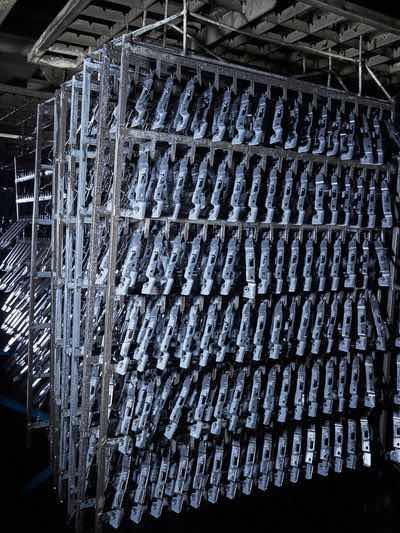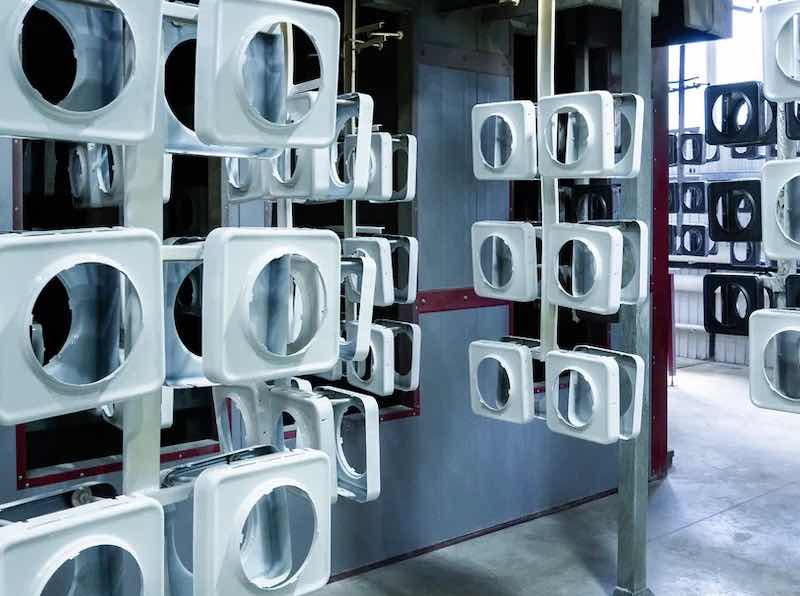In any coating process there are four main requirements: careful surface preparation, the proper coating, a good application system, and a well-designed racking system.
 Dan DavitzOne may ask, “Why would a well-designed racking system be a requirement for any coating process?” It is one thing to coat a sample part for a customer to prove what your capabilities are; however, it is something else altogether to coat the same part on a full production line and make a profit doing it. Making a profit requires coating as many pieces as possible quickly and efficiently while maintaining the highest level of quality.
Dan DavitzOne may ask, “Why would a well-designed racking system be a requirement for any coating process?” It is one thing to coat a sample part for a customer to prove what your capabilities are; however, it is something else altogether to coat the same part on a full production line and make a profit doing it. Making a profit requires coating as many pieces as possible quickly and efficiently while maintaining the highest level of quality.
There are two keys to a profitable production finishing line: the line speed, which determines the number of cycles per hour per day, and the number of parts racked on the line for finishing. The reason that these two keys are so important to a profitable finishing line is that when you consider washing, rinsing, drying, cooling, coating, baking, and handling, along with building space, utilities, waste disposal, and rejects, each of these overhead factors is related to how many part scan be processed per hanger, or per cycle.
In other words, part density directly affects profit. If there is anything that should stimulate your thinking about racking, it should be the impact that high-density racks can have on your production finishing line.
The Well-Designed Racking System
 A well-designed rack will address four areas: part density, proper grounding, rack maintenance, and flexibility.
A well-designed rack will address four areas: part density, proper grounding, rack maintenance, and flexibility.
Part Density
Most racks are welded structures designed to handle as many different parts as possible. Because they are welded, the vertical space between parts is set for the longest part to be hung. When shorter parts are hung, there is wasted vertical space between pieces. The same principle is true when applied to the horizontal spacing between pieces. Part hooks are welded at distances set for holding the widest part and thus, when smaller width parts are hung, the horizontal space between parts is wasted.
With regard to part density, the best type of rack will be adjustable to allow for variables in both the vertical and horizontal spacing and maximize part density in both directions. The side bars of the rack should allow for up-and-down movement of the horizontal cross members to eliminate wasted vertical space. Part hooks should be adjustable at any time (even between cleanings), to be repositioned as close as possible to eliminate wasted horizontal space between parts.
The overall width of a rack should be determined by maximizing the number of pieces on the rack in relation to the distance between conveyor pendants and the degree of incline related to any hills in the system. Most racks are designed to be 20 in. wide and to be center hung on 24-in. centers, assuming a 30° maximum incline/decline.
Proper Grounding for Electrostatic Applications
Nearly all part hooks eventually lose their ground between the part and the hook as they are used through the finishing system. The ground may be lost within as little as 2–3 cycles or as many as10–12 cycles, depending on the amount of paint being applied and whether the same kind of part is hung. A loss of ground causes loss of paint wrap, uneven paint distribution, blemishes, rejects, scrap, and wasted paint, particularly if there is no recovery system.
When loss of ground occurs, it is necessary to either clean the hook or, if possible, remove it and replace it with a clean one. In most cases cleaning requires either burning or chemically stripping the entire rack or burning or grinding just the hook end. The other option, replacing the hook, may be faster depending on the design of the rack and hook connection. There is a rack available that uses spring steel hooks that can be quickly and easily removed even after many cycles. The contact to the rack is shielded from paint and always remains clean for grounding.
Rack Maintenance
Optimizing rack density automatically reduces rack maintenance. Fewer cycles automatically means less cleaning. A common problem with welded racks is the hook breakage that occurs due to the annealing at the weld point of the hook to the rack. This problem causes less product to be painted and gives an inaccurate count of finished parts. Hooks that can be removed and easily replaced are desirable.
Part hooks made of stainless steel will retain strength for a longer period of time, particularly if cleaned in a burn-off oven. Stainless steel is also a requirement if spring steel is used to avoid annealing. Most burn-off ovens operate at approximately 800°F, whereas the annealing temperature of stainless steel is approximately 1,900°F.
Flexibility
Flexibility in racking is very important in any finishing job, large or small. The flexibility achieved with modular racking gives one the ability to concentrate on density and obtain it quickly. Moving part hooks around is not the important part of flexibility. It is having the ability to put a rack together quickly, without welding, and to clean and reuse rack materials for multiple jobs. Modular racking systems offer the ability to stock rack materials for new designs or quick changeover when needed. Some rack companies offer design and engineering for custom rack needs. They can also supply custom hooks that will work with your existing racks.
Summary
Racking parts for density will significantly increase profits. If the parts being finished lend themselves to modular racking, it is well worth the time to address the issues of density, ground, maintenance, and flexibility. Most finishing systems have been designed to run faster than they actually do.
Dan Davitz is an industrial finishing line consultant with over 30 years of experience internationally, specializing in rack design. Contact him at Info@PrismStrategyAndDesign.com



































